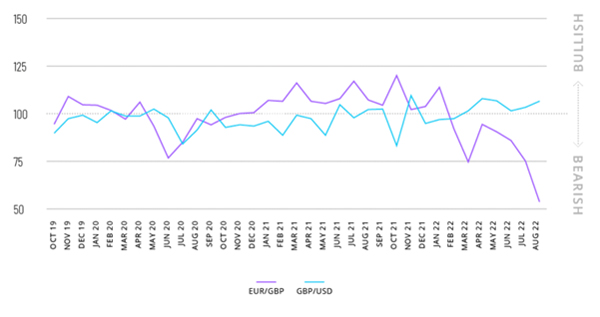- Sentiment in favour of the British Pound compared to both Euro and US Dollar
- Record low sentiment hit on Euro-Pound currency pair
- 123.4 million securitised derivatives were traded on Spectrum Markets in August
Spectrum Markets, the pan-European trading venue for securitised derivatives, has published its SERIX sentiment data for European retail investors for August, revealing strong backing for the British Pound. This can be seen in comparison to the US Dollar, but even stronger against the Euro, where the EURGBP currency pair hit a record low of 54 points since the introduction of the SERIX sentiment data in 2019.
The SERIX value indicates retail investor sentiment, with a number above 100 marking bullish sentiment, and a number below 100 indicating bearish sentiment. See below for more information on the methodology.
The strong GBP sentiment in August might come as a surprise to some as the British Pound has suffered the effects of various recent negative macroeconomic news. This includes the UK reaching the highest level of inflation in more than 40 years, record high consumer prices and various strikes currently taking place in numerous industries as employees demand bigger pay increases to keep up with the pace of inflation.
"There are two possible events which could have contributed to a rather optimistic sentiment towards the Pound”, says Michael Hall, Head of Distribution at Spectrum Markets. “One is the decisive approach taken by the Bank of England, which is currently fighting inflation with interest rate hikes and has raised its key rate several times, most recently to 1.75 percent.”
“Another reason could be more politically motivated”, Hall adds. “Looking ahead to the start of September, investors would have been thinking about whether foreign minister Liz Truss or former finance minister Rishi Sunak would replace Boris Johnson in 10 Downing Street, and either way, with Johnson's resignation, a piece of uncertainty fades from the market. Many European retail investors may have perceived Johnson’s administration as scandal-ridden and erratic and might hope that fresh faces in government will contribute to a more pragmatic and successful economic programme, which will eventually result in a more stable currency.”
In August 2022, 123.4 million securitised derivatives were traded on Spectrum, with 35.2% of trades taking place outside of traditional hours (i.e., between 17:30 and 9:00 CET).
83.9% of the traded derivatives were on indices, 4.8% on commodities, 9.5% on currency pairs, 1.4% on equities and 0.4% on cryptocurrencies, with the top three traded underlying markets being DAX 40 (25.3%), S&P 500 (20.1%) and NASDAQ 100 (12.4%).
Looking at the SERIX data for the top three underlying markets, the DAX 40 remained unchanged at 99. Meanwhile, the S&P 500 slightly increased to 97 from 95 and NASDAQ 100 saw a similar raise, from 97 to 98, remaining in the bearish zone too.

|
Calculating SERIX data The Spectrum European Retail Investor Index (SERIX), uses the exchange’s pan-European trading data to shed light on investor sentiment towards current development in financial markets. The index is calculated on a monthly basis by analysing retail investor trades placed and subtracting the proportion of bearish trades from the proportion of bullish trades, to give a single figure (rebased at 100) that indicates the strength and direction of sentiment: SERIX = (% bullish trades - % bearish trades) + 100
Trades where long instruments are bought and trades where short instruments are sold are both considered bullish trades, while trades where long instruments are sold and trades where short instruments are bought are considered bearish trades. Trades that are matched by retail clients are disregarded. (For a detailed methodology and examples, please visit this link). |




